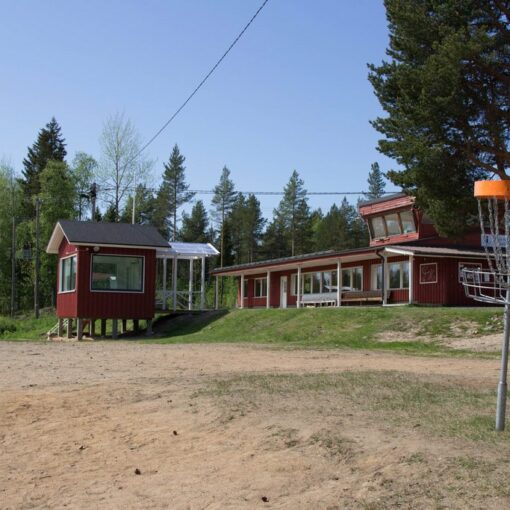Erä Eero is company providing wildlife photographing opportunities in Lieksa, Finland. The cottage has no access to electricity grid. In summer 2021 a photovoltaic (PV) system was installed to get electric power to the cottage. The system includes three polychrystal solar panels inverter and batteries. The cumulative wattage of the system is 870 Wp and the battery capacity is 5 kWh. This allows for lighting the building, cooling a fridge, and charging up customers’ cameras, for example.
“It’s worked very well”
“Don’t need to think day and night if there is enough power. When the clients return from the shooting booths, they can right away plug in their device to charge”
A translated comment of Eero Kortelainen, Erä-Eero’s entrepreneur.

Before the PV system, electricity was generated by aggregate generator. The systems now and before are not easily comparable given their differences. It has been, however, inefficient to generate electricity by a generator because the power demand has been low. Thus, instead of comparing energy generation based on theoretical power output, it is more appropriate to look at the change based on fuel consumption.
Annual fuel consumption has been approximately 250 liters of gasoline. In addition, batteries have been recharged from grid at home by the entrepreneur which the entrepreneur assumes to have saved some 50 liters of gasoline. Direct emissions from burning 300 liters of gasoline equals to ca. 700 kg CO2-eq. The cost with current prices is about 500 € (1,67 €/l).
The PV system costs about 3 500€, including inverter, panels, batteries, regulators, and other miscellaneous parts. The total life-cycle emissions of the PV-system is about 100 kg CO2-eq per year. The number includes dividing each instrument-specific embedded emission by the respective service life and summing them. Thus, each year through the 30-year-long operating time the PV-system saves 600 kg CO2-eq. Similarly, the cost saving results in payback time of less than 15 years, and accounting for the generator investment, too, the figure would be few years less.
Micro water turbine brings light in the house
Erä-Eero wanted to test a micro water turbine in a small stream next to the cottage. A real hydropower installation needs building permission from authorities, but WaterLily-named micro turbine does not because there will be no need to dam the stream. WaterLily is a portable micro-sized water turbine capable of generating 15 W power output and demands higher that 1 m/s flow speed. This is enough to charge a cellphone or use a LED-light, for example. It is possible to attach multiple devices together for a higher power generation. Erä-Eero has two parallel connected WaterLilys for lighting up a Sauna building at least.
Kim Bloinqvist, A project manager from Karelia University of Applied Sciences, gives the following advice for using WaterLilys: “WaterLilys are placed directly into the stream and mounted with mounting equipment provided with the device to the nearest possible point, a tree or stone, for example. Its simple installation makes it easy to change the spot in case the stream changes. The turbines may be installed with a separate pipe to increase the flow speed and power, but a net is needed to filter litter from blocking the pipe. WaterLilys work on 12 V current and with adapters included in the product package it is possible to charge 12 V batteries or USB-devices from USB-ports.”
Please make sure to ask for permission from the local authority before installing a micro-sized water turbine.

See more:
Erä-Eero homepage
See video about Erä-Eero here

UusiutuWat project, Karelia University of Applied Sciences
CBC NatureBeST -Green Nature Based Solutions in Tourism to reduce negative impact on the environment.
Karelia CBC is a Finnish-Russian cross-border collaboration program promoting attractiveness of the region. It is funded by the European Union, Republic of Finland and the Russian Federation




